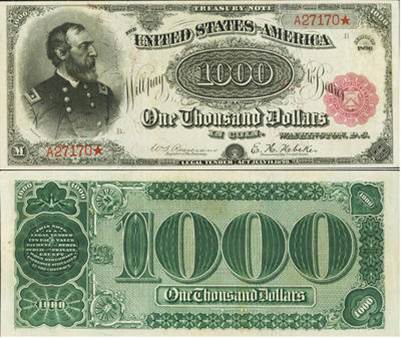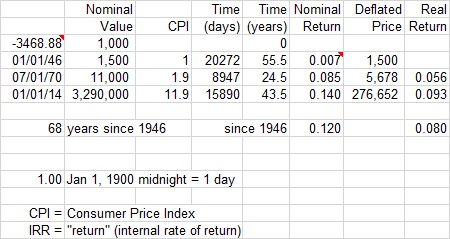
Go
to the Prior Tip To
Forgive Design: Understanding Failure by Henry Petroski
Go to
the Next Tip Brain Bugs by Dean
Buonomano
Return to MaxValue Home Page
On January 10, 2014, a $1000 U.S. Treasury note sold for $3.29 million. This was the highest recorded sale for a piece of currency. This little piece of paper is the most valuable of its kind. [Update: Another sold at auction on October 25, 2018, to an anonymous buyer for $2.04 million.]
The 1890 $1000 Treasury note is popularly called the "Grand Watermelon note" because of the design of the zeros—they look much like watermelons. It is about 50% larger than current bills and is still legal tender.

This same note was sold in 1970 for $11,000.
The last big bills were printed on Dec. 27, 1945. The government asked holders to exchange the large-denomination bills for smaller denominations. Some people held on, as the large ones were increasingly valuable as collectables. Of 18,000 printed, only three remain in private colections.
Has holding the bill been a good investment?
Note: Calculating IRR correctly is much the same as correct PV, FV, inflation, and escalation calculations. One must use the correct discount/escalation rate and pay attention to the time periods.
Let's have some fun with "return" calculations. By return, most people use internal rate of return (IRR).
Let's look at the value of the note at four points in time. We can also adjust for inflation in latter years (I was only able to find inflation tables back to 1929 or so). Also, let's compare the Grand Watermelon to a basket of U.S. stocks (the S&P 500) and 10-year U.S. Bonds.
This table is used to calculate the nominal and real returns for the Grand Watermelon note across three and two time periods, respectively. In this context, nominal means actual prices or "money of the day." When we discuss real return, prices, etc., we are talking about calculations based on inflation-adjusted values (i.e., inflation removed, prices adjusted to dollar values at some reference date).

The four dates are:
July 1, 1890 (Jan. 1, 1900 – 3469 days)
Jan 1, 1946 (approximately when big notes were last printed)
July 1, 1970 (approximate date of the prior sale of this Grand Watermelon note)
January 1, 2014, approximate date of the recent sale.
I guestimated that the note appreciated 50% to $1500 in the 55 years since it was printed. And we have the $11k and $2.29m actual auction prices (ignoring fees, taxes, and insurance).
The "Nominal Return" column shows the geometric average return per year during the first 55.5 years. Average nominal return (IRRnom) = (1500/1000)^(1/55.5) – 1 per year.
The nominal return for the next 24.5 years was IRRnom = ($11,000 / $1,500)^(1/24.5) – 1. = .085 per year. Not bad.
Over the last 43.5 years, IRRnom = ($3.29 million / $11,000)^(1/43.5) – 1 = .140/year. Excellent!
I was unable to find inflation data back to 1890, as represented by the Consumer Price Index (CPI). So let's use only the CPI for years after 1946. Column C shows an "inflation deflator" with value adjusted so that January 1, 1946 represents 1. The nominal values (Col. B) divided by the CPI index provides the real prices (relative to 1946) in column G. Using similar IRR calculation we see the real returns (IRRreal)for the last two segments in Col. H. Holding this note has worked out well for the owners during 1946-2014.
The S&P500 is an index of a basket of large U.S. companies. I added-in dividends so we would have a total return index for the S&P 500 stocks.

Was holding the Grand Watermelon note a good decision? We can't say, because we don't know the values and judgments of the owners at the time they made the acquisitions.
What we can say is that it appears the owners realized good outcomes. The real return for note ownership during the past 68 years has been .068/year. This beats the .055/year real return for the S&P 500. 10-year Treasury Bills, by contrast, yielded only a .018/year return.
If you want to check my numbers and see how these calculations work, the spreadsheet is available at: https://www.maxvalue.com/IRR_GrandWatermelon.xlsx
—John Schuyler, Jan 2014, revised Oct 2018
Copyright © 2014-2018 by John R. Schuyler. All rights reserved. www.maxvalue.com Permission to copy with reproduction of this notice.